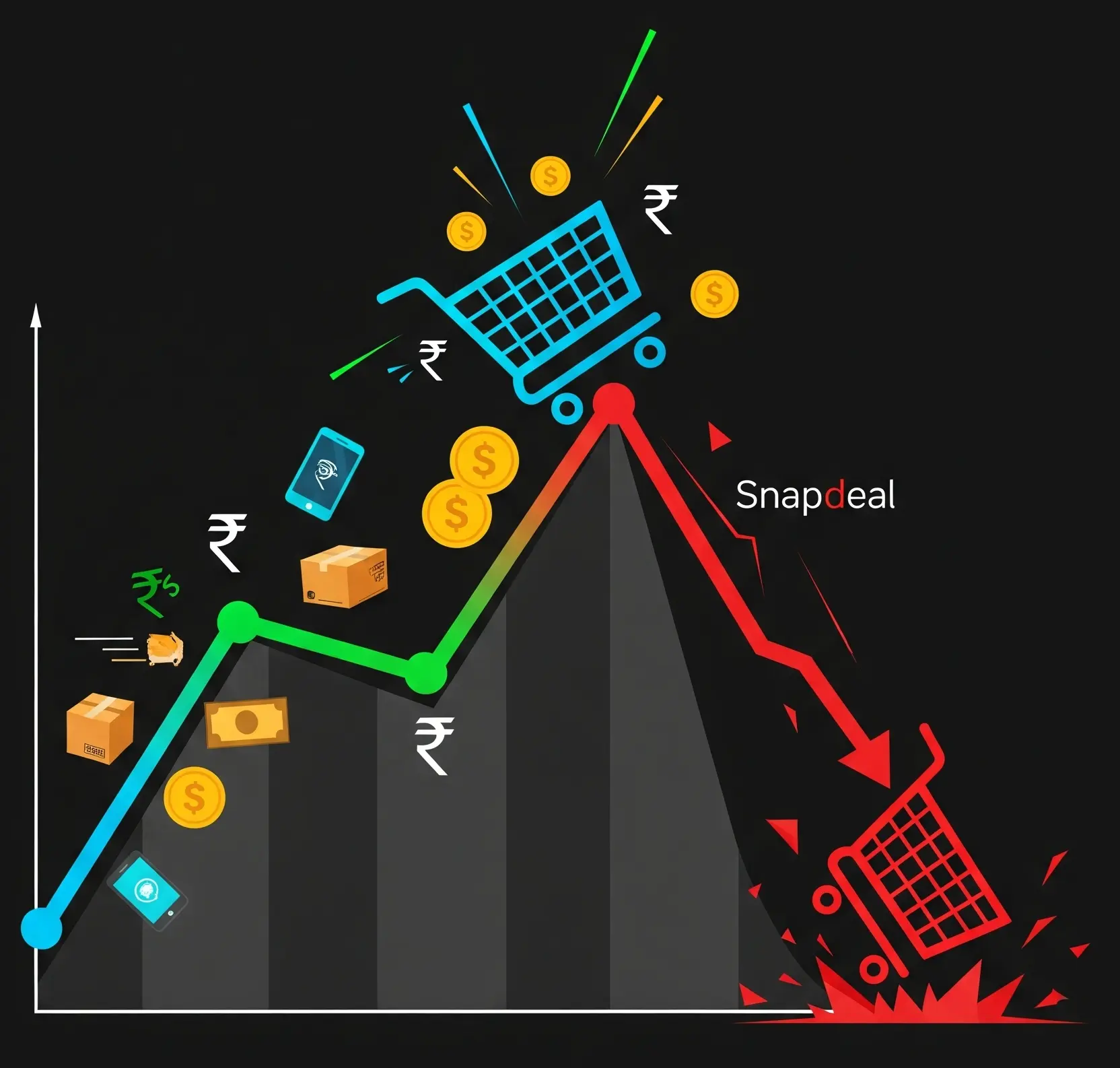
By the middle of the 2010s, Snapdeal had become a unicorn, with a valuation of $6.5 billion by early 2016. However, it lost its footing in a fierce battle for e-commerce dominance. Understanding the dynamics of Snapdeal’s journey is crucial for anyone interested in the evolving e-commerce landscape. Snapdeal was once seen as India’s home-grown competitor to Flipkart and Amazon, but its fortunes changed after a series of mistakes and missed opportunities. Snapdeal is a warning about how aggressive growth, fierce competition, and bad decisions can bring down a promising startup by 2025.
This post dives into great detail about Snapdeal’s rise and fall, including the early success that drew investors’ interest, the significant mistakes that followed, and the valuable lessons that marketers and business owners can learn from them today
India’s e-commerce landscape is evolving rapidly with brands using both online marketplaces and direct-to-consumer (D2C) channels to reach customers. If you want to dive deeper into this retail shift, check out our analysis of FMCG vs D2C competition in India, which highlights how traditional and new-age players are competing for consumer attention.
Snapdeal’s Rise to Prominence
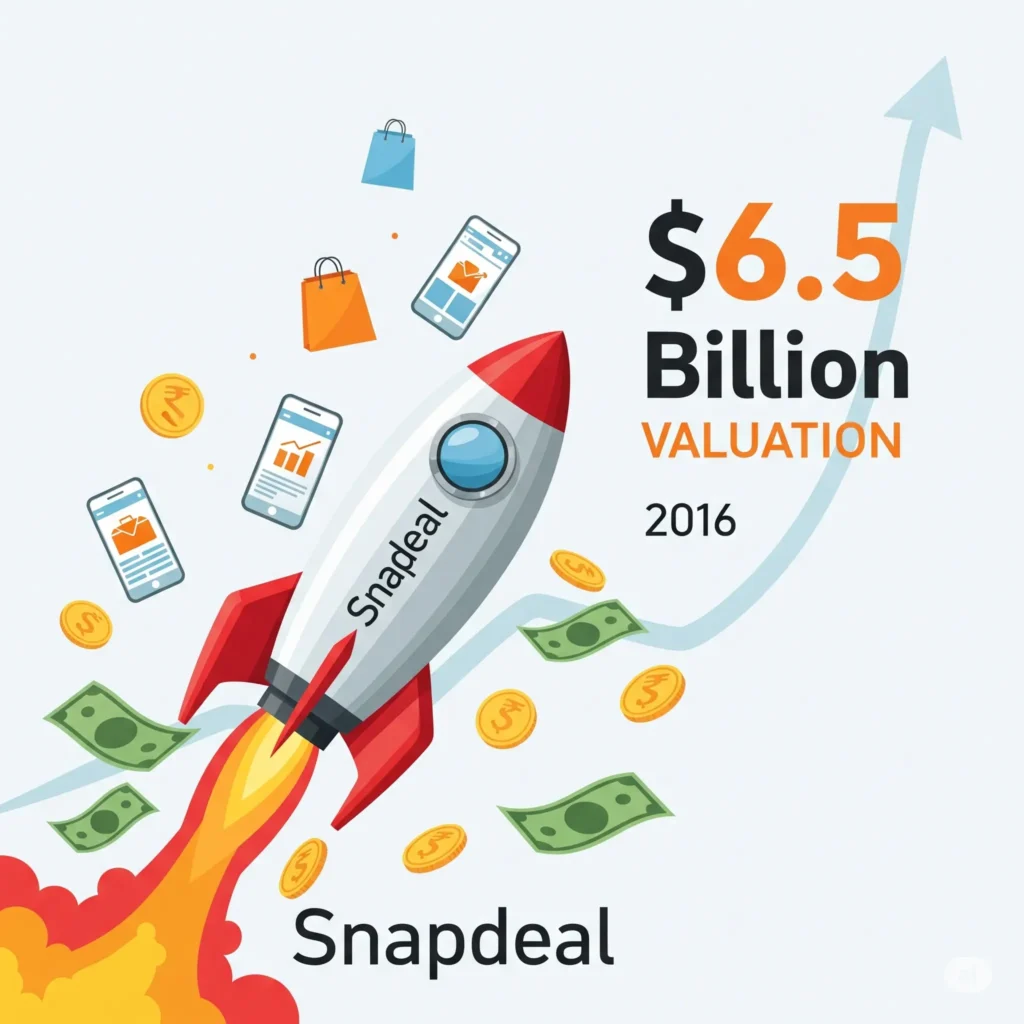
Kunal Bahl and Rohit Bansal started Snapdeal in 2010 as a daily-deals site in Mumbai. It quickly grew into a full-fledged marketplace as India embraced e-commerce.
Between 2013 and 2014, Snapdeal’s gross merchandise value (GMV) skyrocketed, with some reports saying it grew by more than 600% in one year, according to rediff.com. This was because of hundreds of millions of dollars in funding, including SoftBank’s $627 million in 2014.
Snapdeal had more than 100 million registered users and half a million sellers by 2015–16, and it was in a tight race with Flipkart.
Key Reasons for Snapdeal’s Collapse
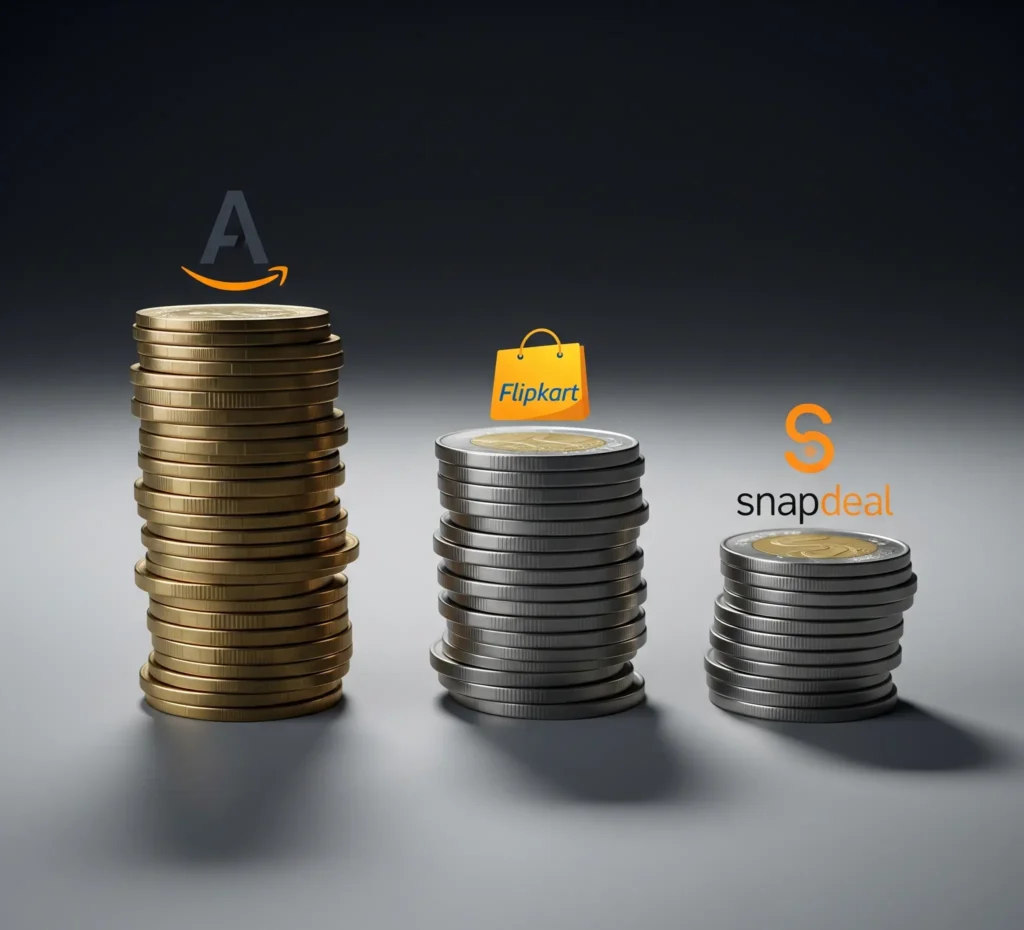
- Fierce Competition & Funding Gap: As Snapdeal grew, its rivals raised vastly more capital. By 2016, Amazon had pumped over $5 billion into India (including a $3B announcement that year), and Flipkart had raised around $3.15 billion. In contrast, Snapdeal’s total funding was roughly $1.5 billion. This cash disparity let Amazon and Flipkart run deep-discount campaigns, build logistics, and subsidize growth. For example, Flipkart and Amazon battled it out on festive sales (Flipkart grabbed ~62% GMV vs. Amazon’s 26% in a Redseer festival snapshot), squeezing smaller players. Snapdeal struggled to match these promotions, and its market share slipped. (By FY16, Snapdeal had already fallen from a growth leader to third place behind Amazon) In short, Snapdeal found itself outgunned in an all-out funding war, which starved it of marketing firepower and scale against the big two.
- High Burn Rate & Unprofitability: Snapdeal’s revenue growth couldn’t keep pace with its spending. In FY2016 (March 2016 year-end), Snapdeal’s losses more than doubled to Rs 3,316 cr (from Rs 1,328 cr a year earlier) even as revenue slowed. The company openly spent heavily on infrastructure: one filing noted major increases “in fulfilment and overhead expenses” to improve customer experience. For the lucrative 2016 festive season, Snapdeal unleashed a costly TV and branding blitz – Rs 200 cr on new ads and logo in Sep–Oct 2016 – but still ceded ground to rivals. In other words, Snapdeal burned cash trying to expand its network and attract buyers, yet it lagged in revenue growth (56% vs 450% a year earlier). The high burn put pressure on its balance sheet and forced later cutbacks. The lesson: running an e-commerce marketplace is extremely cash-intensive, and losing the cash fight means losing market momentum.
- Failed Flipkart Merger (Missed Opportunity): In mid-2017, Snapdeal was in talks to be acquired by Flipkart (a SoftBank-mediated deal) for roughly $900–950 million. However, Snapdeal abruptly pulled out in July 2017 to “pursue an independent path,” even launching its “Snapdeal 2.0” pivot. This was a watershed moment: Flipkart would have become India’s largest e-retailer, and Snapdeal would have exited as part of the deal. Instead, Snapdeal stayed solo at a far lower valuation. The breakdown was stark: Snapdeal’s peak valuation was $6.5B in 2016, but the 2017 Flipkart offer valued it at about $1 billion. Walking away from the merger meant Snapdeal lost a lifeline and had to fend off giants on its own. In retrospect, this was a missed opportunity to pool strengths; instead, Snapdeal remained a third wheel in the market, straining to find its own viable niche.
- Over-Diversification & Acquisition Missteps: Snapdeal’s leadership repeatedly tried new bets that didn’t pan out. The company went on a spending spree of acquisitions and ventures – for instance, it acquired the payments wallet FreeCharge in April 2015. But just two years later, Snapdeal sold FreeCharge to Axis Bank for only Rs 385 cr, a fraction of the purchase price. Similarly, it bought stakes in logistics (GoJavas) and launched private-label ventures, only to later spin them off. In 2016, Snapdeal even set up a wholesale unit (E-Agility) to stock inventory, mimicking Amazon and Flipkart’s approaches, but it never fully integrated it. These side-tracks drained management focus and cash without delivering sustainable revenue. In essence, Snapdeal split its attention: while expanding aggressively into payments and supply chains, it neglected sharpening its core marketplace. The fragmentation meant Snapdeal had neither the financial cushion of Amazon’s all-in-one model nor Flipkart’s twin platform strategy (their Myntra and Jabong fashion arms).
- Snapdeal’s focus on affordable fashion and lifestyle goods mirrors how Indian brands adapt to changing consumer aspirations. For example, Fabindia’s unique brand love story shows how cultural relevance and affordability drive loyalty in competitive markets.
- Strategic Pivot (Snapdeal 2.0) Backfires: In July 2017, amid its troubles, Snapdeal announced “Snapdeal 2.0”: a laser focus on “value commerce” for India’s price-conscious shoppers (businesstoday.in). It dropped high-end categories (like smartphones and large appliances, which were ~50–60% of business) and doubled down on budget fashion, home goods and general merchandise (businesstoday.in). The emphasis: most products under ₹1,000, catering to Tier-II+ markets (businesstoday.in). However, this drastic shift hammered Snapdeal’s topline – revenue from operations plummeted from Rs 1,158.9 cr (FY16) to Rs 436.1 cr (FY18) (businesstoday.in). In other words, Snapdeal traded volume for niche focus and saw its business shrink. While the new model later showed promise, the sudden pivot cost it years of growth. Customers who came to Snapdeal for variety and deals drifted to Amazon/Flipkart when their favorite categories vanished. The lesson: overhauling a business can alienate your existing base – transitions need careful pacing and communication.
- Logistics & Fulfillment Gaps: Snapdeal never built a logistics network on par with the competition. It mostly relied on third-party services and startups (e.g., acquiring Unicommerce for order management (en.wikipedia.org) and launching Snapdeal Express). This meant slower, less reliable deliveries compared to Flipkart’s Ekart or Amazon’s fulfillment centers. Documents confirm Snapdeal increased fulfillment costs in FY16 (livemint.com), but its order-to-door times remained longer. In fast-moving e-commerce, delays hurt customer loyalty, especially when Amazon Prime offered one-day shipping elsewhere. Snapdeal’s limited control over inventory (until E-Agility in late 2016 (livemint.com)) also hurt stock availability. In short, Snapdeal customers often got the deals but not the quick service – a key competitive edge lost.
- Quality & Brand Perception Issues: Over time, Snapdeal’s brand became associated with “cheap but unpredictable” goods. Many marketplace sellers offered unbranded or counterfeit items, and Snapdeal struggled with returns and complaints. (It famously ran a “Brand Waali Quality, Bazaar Waali Deal” campaign to reassure customers (marketingmonk.so).) In contrast, Amazon invested early in vetting sellers and building trust (A-to-Z Guarantee, Prime reliability). Snapdeal’s fighting words could not fully erase the reputation for occasional dud purchases. In a market where word-of-mouth is everything, this perception gap drove some shoppers toward Flipkart (focus on big brands) or Myntra/Amazon for trusted fashion.
- Marketing vs. Profit Dilemma: To fuel growth, Snapdeal burned money on marketing – even when cash was tight. It splurged on celebrities and large-scale campaigns, yet ROI was limited. For example, during the 2016 sale season, Snapdeal spent an eye-popping Rs 200 cr on ads (livemint.com). However, Flipkart and Amazon were simultaneously spending even more (for context, Walmart later reported Flipkart’s festive marketing also ran into hundreds of crores). After 2016, Snapdeal had to slash spending dramatically. By FY24, it had cut its marketing budget by ~60% (indianstartupnews.com) to survive. The message: high visibility is vital, but not at the cost of profitability. Snapdeal’s experience shows that blowing cash on hype can backfire if the underlying business isn’t healthy – and once the funds dry up, competitors fill the void.
Unlike giants such as Amazon and Flipkart, Snapdeal positions itself as a value-focused platform. A useful comparison can be drawn from the strategies of electronics sellers online—read our detailed take on modern electronics sales strategies across retail and e-commerce.
Watch this video case study: Why Snapdeal Failed? ⛔ The Rise and Fall to see a visual breakdown of the e-commerce giant’s decline.
Case Studies: Lessons from Competitors
Snapdeal vs. Flipkart (and Amazon): Flipkart (later acquired by Walmart) and Amazon took very different paths. Flipkart went all-out on scale: it raised massive funding (e.g., Walmart/Google $950M in 2025), built Ekart logistics, and expanded its portfolio via acquisitions (Myntra, PhonePe, Shopsy, etc.). Flipkart also created new verticals – notably Shopsy, its app targeting value shoppers – which exploded recently (3× growth in Q1 2023, 16 million customers added). Amazon, backed by global capital, rolled out Prime, huge warehouses and its payment platform. Both offered broad selections (electronics, fashion, grocery) with robust customer service. Snapdeal’s approach was narrower: it tried to win on price and seller variety, without matching this ecosystem. For instance, Flipkart captured a whopping 62% of festive GMV in 2022, while Snapdeal’s share was negligible. Moreover, Flipkart invested in growth even during losses, whereas Snapdeal trimmed back. In practice, Flipkart and Amazon effectively “took the highway” of national scale and infrastructure; Snapdeal tried side streets – a higher-risk strategy. The result: the giants captured most users and mindshare, leaving Snapdeal with scraps despite an early lead in value e-commerce.
Snapdeal vs. Meesho: Meesho is a rising star that cornered the “value” segment differently. Starting as a social commerce platform (resellers selling via WhatsApp/Facebook), Meesho grew explosively in smaller towns. It boasted 135% YOY order growth in late 2022 and, in fact, overtook Amazon to capture the second-highest number of orders in that festive period. By mid-2023, Meesho even reported a post-tax profit – a first for India’s horizontal marketplaces. Importantly, Snapdeal’s own investor SoftBank (35% owner) backed Meesho instead of doubling down on Snapdeal, a telling vote of confidence. Meesho’s model leveraged social networking and near-zero commission for sellers (building loyalty), whereas Snapdeal had no such “social” moat. In essence, both targeted the same budget-conscious consumer, but Meesho’s fresh, community-driven strategy won more minds and wallets. Snapdeal’s later pivot to that segment (e.g. vernacular interface, quality checks) was reactive. The competition shows that even in the value space, how you serve customers (socially, reliably, quickly) matters as much as price.
Snapdeal’s trajectory also reflects broader startup and digital growth trends in India. If you’re interested in how other ventures are scaling, don’t miss our piece on startup growth hacks for 2025 and how micro-SaaS businesses are expanding in India.

Lessons for Startups in 2025
Snapdeal’s journey yields actionable takeaways for today’s entrepreneurs and marketers:
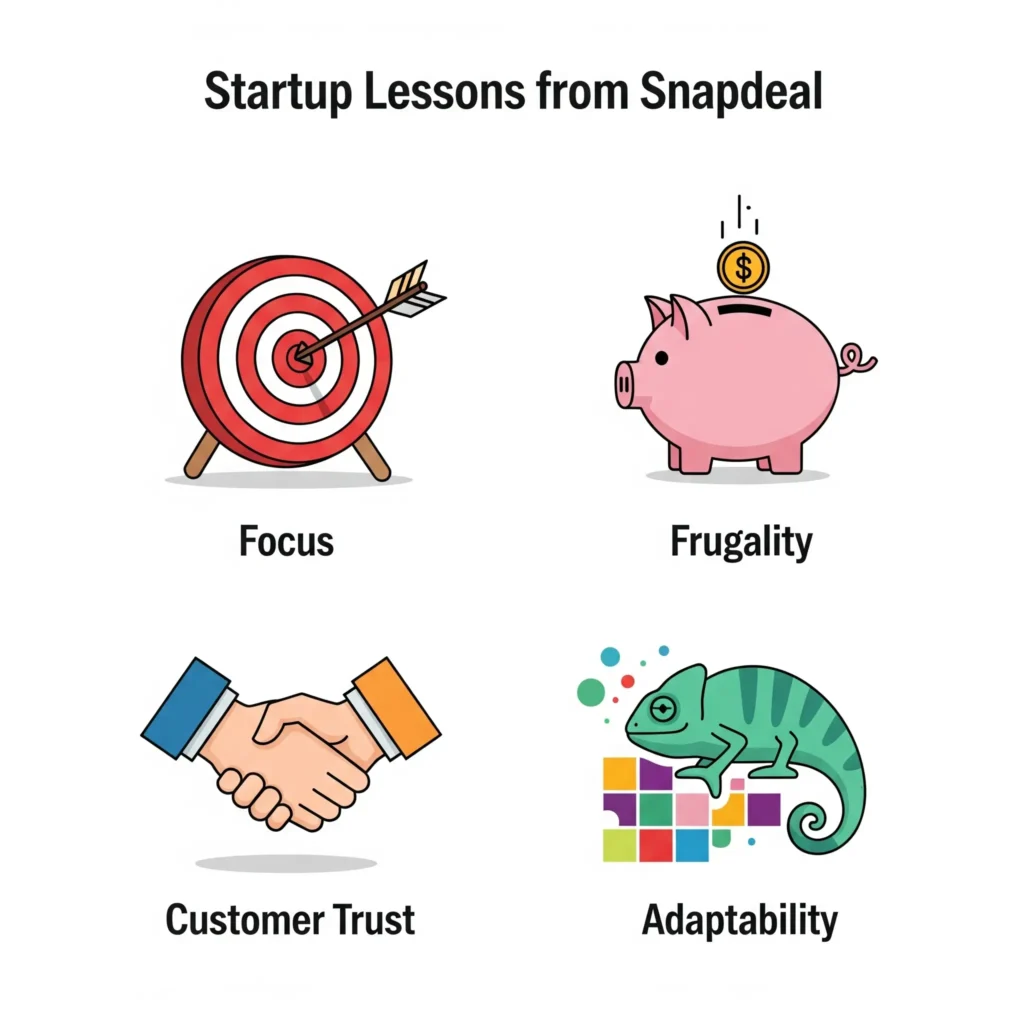
- Master Your Core Strengths. Keep focus. Snapdeal’s comeback began when it doubled down on its main niche – value-oriented goods – and cut flab. Likewise, startups should identify their “sweet spot” and excel there before diversifying.
- Watch Your Burn. Deep-pocket rivals can outspend you. Snapdeal’s cuts in marketing and overhead paid off: FY24 losses shrank 43% by slashing ad spend by 60%. Always balance growth spending against a clear path to profit.
- Prioritize Customer Trust and Experience. Quality, speed, and service cannot be afterthoughts. Snapdeal’s pitfalls on product quality and delivery helped competitors lure away its users. Invest early in logistics tech and seller vetting.
- Adapt Quickly, But Thoughtfully. Snapdeal learned (sometimes painfully) to serve non-metro customers via local languages and curated products. However, abrupt strategic swings hurt it. In 2025, embracing trends (social commerce, AI personalization, vernacular interfaces) is crucial – but test and phase changes.
- Learn from the Market Leaders. Study Flipkart’s end-to-end retail engine and Amazon’s user obsession; copy the elements that fit your model. For example, language support and AI-driven recommendations (areas Snapdeal later added) can be differentiators.
- Be Resourceful and Lean. When Snapdeal could not match Amazon’s budget, it chose to be nimble, later finding profitability through lean operations. Today’s startups should similarly iterate fast, conserve runway, and use data to find pockets of underserved demand.
Together, these lessons point to a simple mantra: focus on doing a few things extremely well, rather than spreading yourself thin. Snapdeal’s rebound (and industry trends) shows sustainable strategies beat short-term hype.
Conclusion
Snapdeal’s fall from unicorn fame wasn’t just bad luck; it was based on real things. Snapdeal overexpanded, changed direction too late, and had trouble with logistics and quality when it had to compete with much richer companies. Even though it still exists as a niche player, its story is a clear warning: Big raises and flashy ads can’t replace good strategy and execution. Snapdeal is a great example for marketing students and young business owners. Look at how Flipkart’s data-driven growth and Meesho’s social model worked, and learn from Snapdeal’s mistakes: Keep an eye on the burn rate, get to know your customers well, and be ready to cut your losses and start over.
Snapdeal’s journey is calling you; do your research on what worked (and what didn’t) here. Try out small, long-lasting changes; look at the playbooks of successful brands; and always make sure your strategy aligns with what’s really going on in the market. A startup can only hope to survive (and do well) in the competitive e-commerce world of 2025 if it does this.
In the end, Snapdeal’s journey is also part of a bigger narrative about how Indian companies build brands that resonate with local consumers. You can explore more in our article on modernizing Indian branding and the myth of the self-made brand.
What do you think was the single biggest factor in Snapdeal’s collapse — fierce competition, risky pivots, or something else? Share your thoughts below!
External resources: For more context on India’s e-commerce boom and strategies, see Snapdeal’s official site (snapdeal.com) and recent industry reports like Redseer’s “Demystifying India’s E-Commerce Growth” and IBEF’s 2025 E-Commerce Industry Report.
All Sources & Further Reading
- Reuters — Snapdeal raises $200M, valuing it at $6.5B (2016)
- Wikipedia — Snapdeal (overview)
- Rediff — Was 2014 the breakthrough year for India’s e-commerce?
- Snapdeal Blog — Snapdeal’s edge in value e-commerce (2024)
- TechCrunch — Amazon to pump $3B more into India (2016)
- ET Retail — 2023: India’s evolving e-commerce market (Redseer)
- Mint — Snapdeal losses more than doubled in 2015–16
- Business Today — Flipkart’s plan to acquire Snapdeal fails (2017)
- MarketingMonk — The rise, fall, and rise again of Snapdeal
- Indian Startup News — Snapdeal trims losses by 43% in FY24
- IBEF — E-commerce industry in India (overview)

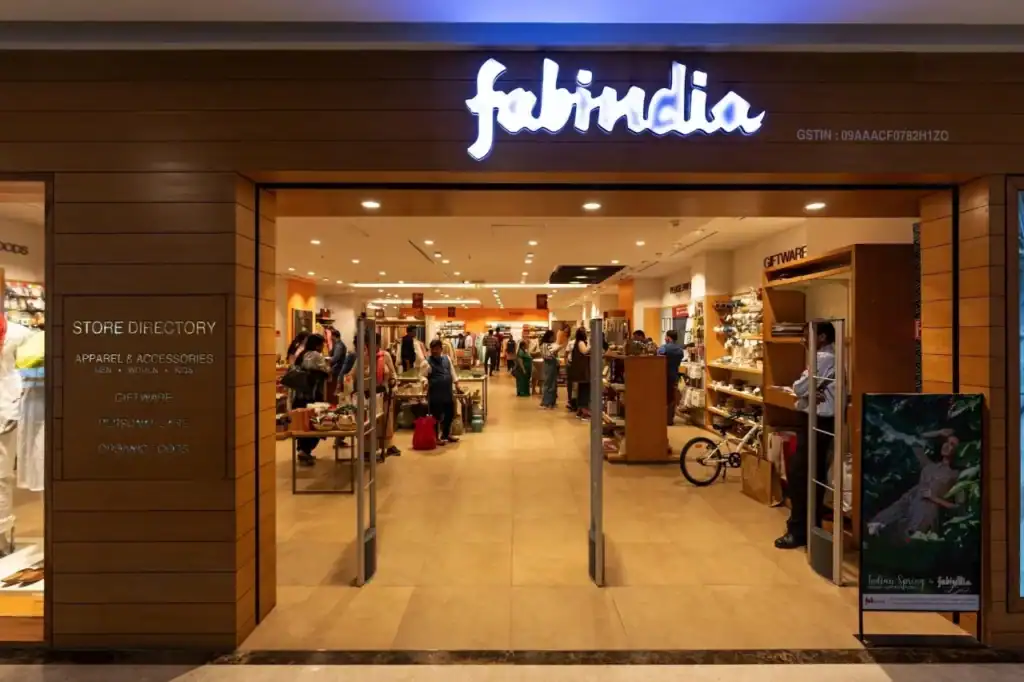
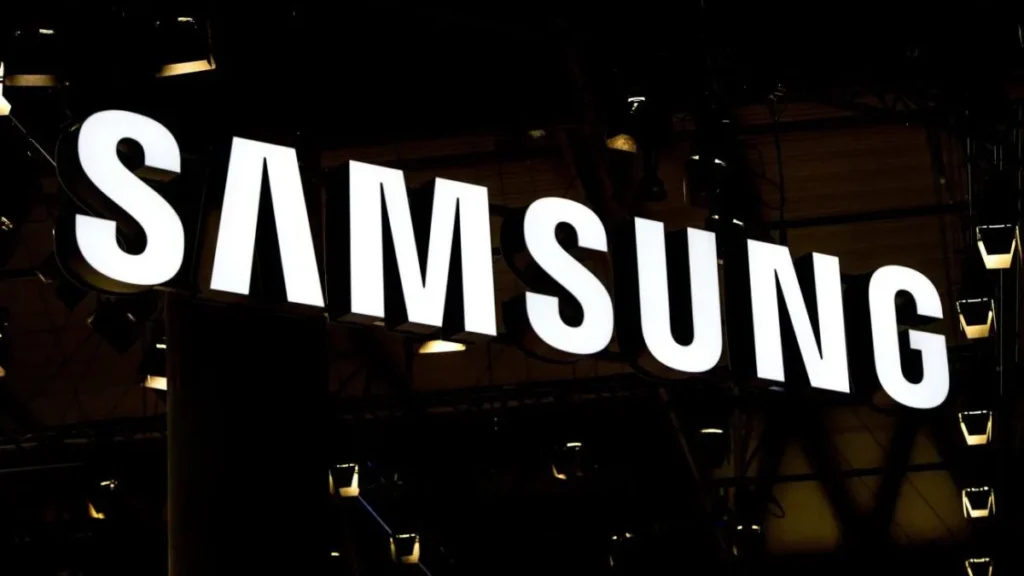

Excellent in depth analysis of the Snapdeal failure. Gotten to know very different facets of the company. Keep it up…. Waiting for new one
Excellent in depth analysis of the Snapdeal failure. Gotten to know very different facets of the company. …. Waiting for new one